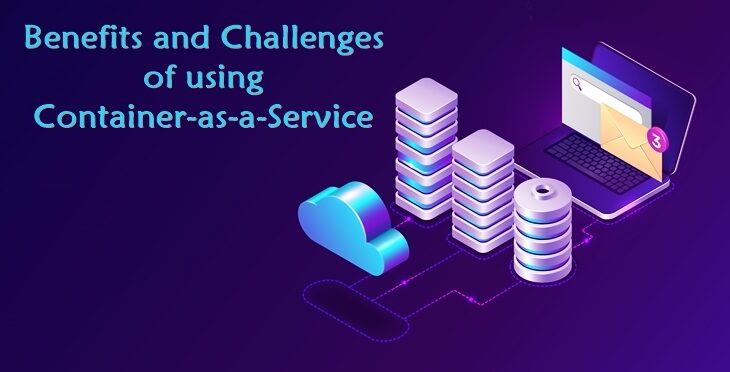The development of software and applications can be resource-intensive. Most SMEs lack the resources needed to code applications and test them efficiently. This challenge intensifies when the workforce is working across geographies. It is demanding for enterprises to set up and maintain the required IT infrastructure A lot of capital is invested with little to no return. This has opened up opportunities in the Cloud space with players offering cloud-based solutions for these enterprises. Cloud solutions such as Platform-as-a-Service and Container-as-a-Service are a boon for such enterprises. It allows them to function at the best efficiency level along with saving significant capital for their operations.
One of the most sought after service for enterprises is Container-as-a-Service (CaaS). It is the provision of Containers by Cloud service providers, to enterprises, at a reasonable fee. Containers are the virtual spaces in which developers can code and execute programs similar to virtual machines. The difference here is the non-dependency of containers on the base operating system. This allows developers and testers to effectively work on the code without the various issues caused due to varying operating systems. Cloud services provide containers to enterprises on their Cloud infrastructure as a service, hence CaaS.
Industry experts have been debating over various advantages and disadvantages of containers. It is not a perfect solution, but it better than many others. Containers are a product of software evolution, which began from the creation of Virtual Machines. IT professionals are using Containers since it has some clear advantages over similar
offerings. They are as follows:
One of the primary reasons why professionals are using containers is because of their resource-friendly nature. It consumes fewer resources, allowing developers to run more containers with the same hardware. Moreover, it also requires less computing power to operate since there is no additional need to operate a different operating system within the container. This allows enterprises to invest less in hardware, saving operating costs further.
Containers, unlike virtual machines, are not dependent on any operating system or Cloud platforms. They do not need to create another instance of an operating system. This makes it easy to run the containers and the applications within them with ease. This opens up the possibility of multiple options of Cloud providers for enterprises to choose from.
Containers are lightweight and measure in Megabytes. This allows them to boot up and function swiftly. Developers can thus run their applications and develop and test them effectively. This helps overall speed the process of development. Enterprises are therefore able to take the product to market quicker.
Since containers are not dependent on other operating systems to operate, they do not have to depend on the underlying OS to perform any operations. Thus, the data used within the container cannot be accessed by any other program but the container itself. This removes the risk of data being shared to other programs or being susceptible to leak. Since many-a-times developers work with sensitive company data, it is crucial to safeguard the data from cyber-attacks.
Also Read: CaaS vs. IaaS: What’s the Difference Between the Two?
Containers are light and quick to work with, and hence it is effortless to create containers and destroy them. Sometimes if the program that is being run within the container happens to run into an endless issue, the container can simply be killed. This ensures that the entire hardware is not affected and resources are not consumed continually owing to the issue.
Sometimes there might be a need to provide additional resources to a container because an application is demanding so. This is easy to do in containers. Their resources can be scaled both up and down with ease. This way, only the required amount of resources can be used whenever needed or increased if required.
One of the significant challenges during the development phase of an application is the gap between development and testing. Whenever an application is run on some operating system, a new image of the application is created. This is because of the nature of data being processed by the application instance. Moreover, the operating system being used and many other settings and parameters impact the performance of the application. Hence, if an application worked perfectly fine on one system, it might shoot a bug on some other system. To counter this, containers are helpful as they provide an independent and standard set of conditions for everyone. The development and testing teams can both work on the same image of the application. The results are much accurate this way.
Being lightweight has its advantages for containers. As containers are fast, they are extremely portable. One can simply shift the container from one platform to another. This can range from between systems, physical servers, virtual servers, Cloud, etc. This gives the enterprises a lot of convenience, flexibility, and improved speed to work with.
Containers are deemed safer than its peers such as Virtual Machines, but it does have a certain risk factor. Even though they are platform agnostic, containers do share the same kernel with the underlying operating system. This makes containers vulnerable to some attacks if they are specifically targeted. The risks increase further when containers are being used on the Cloud through CaaS.
Containers are lightweight and easy to create and destroy, but they also need substantial technical expertise. Most enterprises struggle with the development of containers since they lack the required technical know-how. On the other hand, not all applications are compatible with containers. This requires enterprises to add certain capabilities to the applications or containers to ensure they perform well.
Enterprises often use CaaS to keep their operating costs low. But, there is one aspect they fail to consider, which often turns out to be the Achilles heel for them. Containers are easy to launch. Hence developers take this for granted and forget about reusing containers. They launch new containers every time they want to run an application. Over time, there are a lot of containers open on the Cloud simultaneously. This creates a Container mess, and all the open containers contribute to the consumption of a substantial amount of storage and bandwidth. The container mess eventually results in an increased Cloud bill for the enterprise.
Containers are virtual environments and do not run directly on bare metal. There is a certain performance lag with the added layer between bare metal and containers of an operating system and its kernels. Combine this with the networking losses of the container interfacing with the host system; the result is a significant loss of performance. Hence, enterprises have to deal with some loss in the containers' performance even after a superior hardware infrastructure available. Therefore, it is sometimes preferred to run applications on bare metal to test the application's full performance potential.
Conclusion
There is a reason why a lot of industry professionals swear by containers. The advantages containers offer is much beyond any disadvantages it might possess. The sheer simplicity of its operation, the resource friendliness, agility, and portability make it a clear favorite in the coding community.
You May Also Like to Read:
Understanding AI as a Service Examples Across Industries
Top 9 Docker Use Cases
CaaS vs. PaaS: Understand the Difference Between Two





